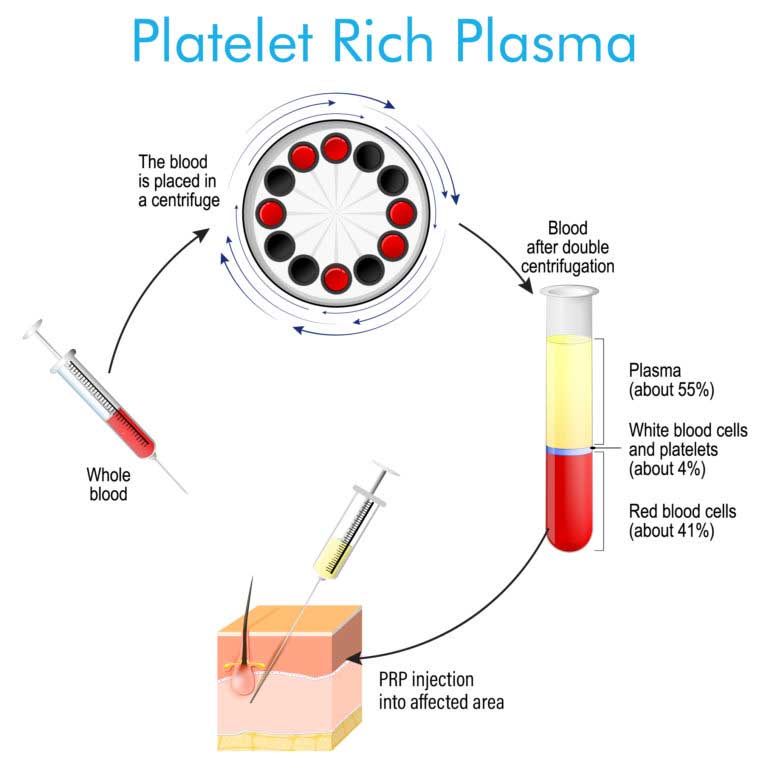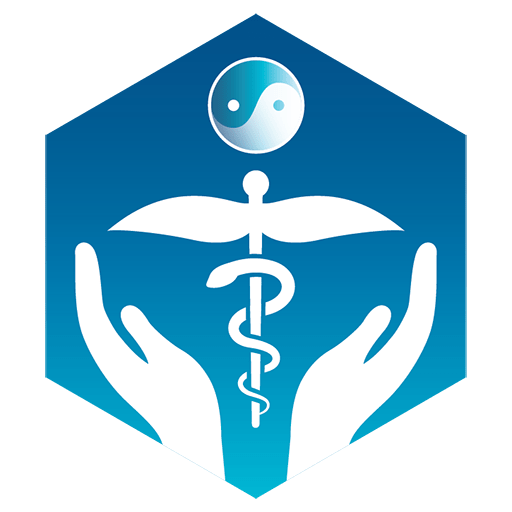PRP Therapy
PRP therapy has become quite popular recently. This is a result of many athletes having been treated with it. Why? Because it helps the body heal injuries possibly more completely and more efficiently than the body might do otherwise. Following an injury, the body initiates the healing process both by making growth factors and by releasing growth factors from platelets. Platelets are fragments of cellular tissue which circulate in the blood and help to stop the bleeding associated with an injury. In addition, they store over 200 growth factors which are released into the tissue following an injury.
There is scientific evidence to suggest that the healing of an injury can be more rapid and effective, up to a point, if the concentration of growth factors is higher rather than lower.
Techniques have been developed to separate and concentrate platelets from the blood drawn from a patient. This solution is called “platelet rich plasma” or “PRP.” This PRP can then be injected into the injured tissue to facilitate the healing process. Dr. Kochan does these injections with ultrasound guidance which allows him to see that the PRP is being delivered to the exact site of injury and other associated structures.
 Is there a guarantee of a beneficial effect or outcome with PRP? No treatment can give you a guarantee of success, but Dr. Kochan’s experience with his patients has been quite positive. In addition, he has had PRP treatment of his knees and shoulders and other joints with good results.
Is there a guarantee of a beneficial effect or outcome with PRP? No treatment can give you a guarantee of success, but Dr. Kochan’s experience with his patients has been quite positive. In addition, he has had PRP treatment of his knees and shoulders and other joints with good results.
Additional information…
Until 2007, the primary use of autologous PRP was by thoracic surgeons to improve healing of sternal incisions and decrease incidence of infections after thoracotomy in cardiac surgery. Shortly after that, oral-facial surgeons in oral, maxillofacial, and plastic surgery started using PRP to prevent bone loss and promote bone formation and wound healing in conjunction with implants and oral reconstructive surgery. More recently, its use has expanded to include injections of PRP in sports and musculoskeletal medicine to help the body heal joint, ligament, and tendon injuries.
As stated previously, studies have indicated that increasing the concentration of platelets at the area of an injury may facilitate healing. Platelet concentrations can be made to contain between four and eight times the baseline concentration of platelets and thus growth factors in whole blood. This can be changed depending on the needs of the patient as determined by the doctor. This platelet concentrate contains many different growth factors, among them PDGF, IGF-1, TGF-1beta, EGF, and VEGF. It also has the ability to attract mesenchymal signaling cells/ MSCs (also incorrectly labeled as stem cells) which have the ability to direct regeneration of many types of tissue.
Dr. Kochan has had significant success treating patients with knee arthritis with prolotherapy alone. However, sometimes in more severe arthritis, or if there is a torn or degenerated meniscus or ligament, a combination of prolotherapy and PRP treatments is necessary. Many patients have had relief of pain and return of function including the ability to walk and climb stairs without pain.
A few well-designed sports medicine studies using PRP have had very positive outcomes. In one study, nearly all symptoms of plantar fasciitis resolved within 4-8 weeks, and ultrasound visualization showed increases in tissue integrity and organization. In another study, rotator cuff tears showed marked reduction of symptoms and tissue healing, sometimes after a single treatment. Lateral elbow tendinopathy (tennis elbow) has responded to a single treatment in two different studies with significant relief of symptoms.
 It is Dr. Kochan’s belief that, except in rare cases, treatment with PRP should generally be preceded by prolotherapy treatment. There are several reasons for using PRP in conjunction with or even preceded by prolotherapy treatment:
It is Dr. Kochan’s belief that, except in rare cases, treatment with PRP should generally be preceded by prolotherapy treatment. There are several reasons for using PRP in conjunction with or even preceded by prolotherapy treatment:
• The growth factors released from platelets need to attach to receptors in an injury to cause a healing effect. If the structure to be treated with PRP is not actively healing as from an acute injury or after prolotherapy, then the growth factors released into that area will have fewer tissue receptors to attach to.
• The quantity of PRP obtained from a single blood draw is limited to only a few milliliters, so it is often used to treat only the structure or structures that are primarily responsible for the pain and/or dysfunction. In an acute injury it is common that other structures in the area are injured. These supporting tissues also need to be evaluated and strengthened. If there is not enough PRP to treat these areas, then prolotherapy can be used to help heal the secondary support structures. If this is not done, the underlying instability and weakness of these supporting tissues can eventually cause the repair to fail and the problem can recur.
PRP injection treatment may decrease the number of prolotherapy treatments necessary for healing and possibly shorten the time course of healing. This is something that is discussed on a case-by-case basis with Dr. Kochan.
Dr. Kochan also feels that due to the expense and the need to deliver the PRP to the correct spot, that PRP injections should be performed under ultrasound guidance, which allows the physician to see the lesion being treated and deliver the PRP to that exact site.
 There are few negative aspects of PRP. The pain after treatment usually lasts for only two or three days, but in rare circumstances can be significant for periods of time of up to a couple of weeks. The pain of treatment is generally well controlled with ice and acetaminophen, but sometimes will require stronger analgesics. Another drawback is the cost, which is not insignificant, and not covered by insurance (so what’s new?).
There are few negative aspects of PRP. The pain after treatment usually lasts for only two or three days, but in rare circumstances can be significant for periods of time of up to a couple of weeks. The pain of treatment is generally well controlled with ice and acetaminophen, but sometimes will require stronger analgesics. Another drawback is the cost, which is not insignificant, and not covered by insurance (so what’s new?).
PRP injection treatment may be the only available alternative to a painful and costly surgery. Surgery, even if it is successful, may be disabling for a time and require a long recovery and being off work. PRP treatment rarely causes disability or more than a few days off work. Thus, in the long run, it may be less expensive and less disabling than surgery, and can be successful in improving function and decreasing pain in situations where surgery is not even an option.
